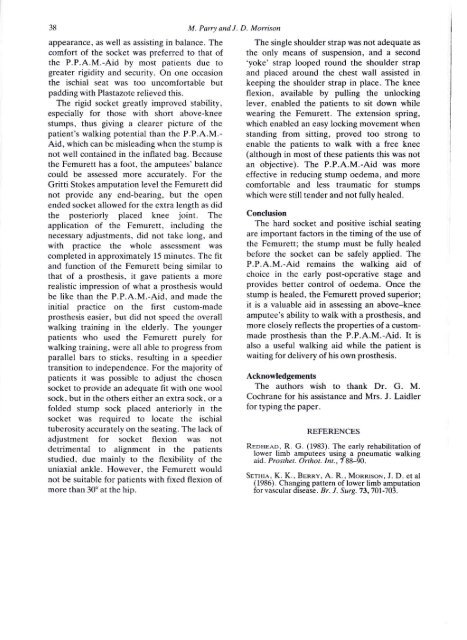Use of the Femurett adjustable prosthesis in the assessment and ...
Use of the Femurett adjustable prosthesis in the assessment and ...
Use of the Femurett adjustable prosthesis in the assessment and ...
You also want an ePaper? Increase the reach of your titles
YUMPU automatically turns print PDFs into web optimized ePapers that Google loves.
38 M. Parry <strong>and</strong> J D. Morrison<br />
appearance, as well as assist<strong>in</strong>g <strong>in</strong> balance. The<br />
comfort <strong>of</strong> <strong>the</strong> socket was preferred to that <strong>of</strong><br />
<strong>the</strong> P.P.A.M.-Aid by most patients due to<br />
greater rigidity <strong>and</strong> security. On one occasion<br />
<strong>the</strong> ischial seat was too uncomfortable but<br />
padd<strong>in</strong>g with Plastazote relieved this.<br />
The rigid socket greatly improved stability,<br />
especially for those with short above-knee<br />
stumps, thus giv<strong>in</strong>g a clearer picture <strong>of</strong> <strong>the</strong><br />
patient's walk<strong>in</strong>g potential than <strong>the</strong> P.P.A.M.-<br />
Aid, which can be mislead<strong>in</strong>g when <strong>the</strong> stump is<br />
not well conta<strong>in</strong>ed <strong>in</strong> <strong>the</strong> <strong>in</strong>flated bag. Because<br />
<strong>the</strong> <strong>Femurett</strong> has a foot, <strong>the</strong> amputees' balance<br />
could be assessed more accurately. For <strong>the</strong><br />
Gritti Stokes amputation level <strong>the</strong> <strong>Femurett</strong> did<br />
not provide any end-bear<strong>in</strong>g, but <strong>the</strong> open<br />
ended socket allowed for <strong>the</strong> extra length as did<br />
<strong>the</strong> posteriorly placed knee jo<strong>in</strong>t. The<br />
application <strong>of</strong> <strong>the</strong> <strong>Femurett</strong>, <strong>in</strong>clud<strong>in</strong>g <strong>the</strong><br />
necessary adjustments, did not take long, <strong>and</strong><br />
with practice <strong>the</strong> whole <strong>assessment</strong> was<br />
completed <strong>in</strong> approximately 15 m<strong>in</strong>utes. The fit<br />
<strong>and</strong> function <strong>of</strong> <strong>the</strong> <strong>Femurett</strong> be<strong>in</strong>g similar to<br />
that <strong>of</strong> a pros<strong>the</strong>sis, it gave patients a more<br />
realistic impression <strong>of</strong> what a pros<strong>the</strong>sis would<br />
be like than <strong>the</strong> P.P.A.M.-Aid, <strong>and</strong> made <strong>the</strong><br />
<strong>in</strong>itial practice on <strong>the</strong> first custom-made<br />
pros<strong>the</strong>sis easier, but did not speed <strong>the</strong> overall<br />
walk<strong>in</strong>g tra<strong>in</strong><strong>in</strong>g <strong>in</strong> <strong>the</strong> elderly. The younger<br />
patients who used <strong>the</strong> <strong>Femurett</strong> purely for<br />
walk<strong>in</strong>g tra<strong>in</strong><strong>in</strong>g, were all able to progress from<br />
parallel bars to sticks, result<strong>in</strong>g <strong>in</strong> a speedier<br />
transition to <strong>in</strong>dependence. For <strong>the</strong> majority <strong>of</strong><br />
patients it was possible to adjust <strong>the</strong> chosen<br />
socket to provide an adequate fit with one wool<br />
sock, but <strong>in</strong> <strong>the</strong> o<strong>the</strong>rs ei<strong>the</strong>r an extra sock, or a<br />
folded stump sock placed anteriorly <strong>in</strong> <strong>the</strong><br />
socket was required to locate <strong>the</strong> ischial<br />
tuberosity accurately on <strong>the</strong> seat<strong>in</strong>g. The lack <strong>of</strong><br />
adjustment for socket flexion was not<br />
detrimental to alignment <strong>in</strong> <strong>the</strong> patients<br />
studied, due ma<strong>in</strong>ly to <strong>the</strong> flexibility <strong>of</strong> <strong>the</strong><br />
uniaxial ankle. However, <strong>the</strong> <strong>Femurett</strong> would<br />
not be suitable for patients with fixed flexion <strong>of</strong><br />
more than 30° at <strong>the</strong> hip.<br />
The s<strong>in</strong>gle shoulder strap was not adequate as<br />
<strong>the</strong> only means <strong>of</strong> suspension, <strong>and</strong> a second<br />
'yoke' strap looped round <strong>the</strong> shoulder strap<br />
<strong>and</strong> placed around <strong>the</strong> chest wall assisted <strong>in</strong><br />
keep<strong>in</strong>g <strong>the</strong> shoulder strap <strong>in</strong> place. The knee<br />
flexion, available by pull<strong>in</strong>g <strong>the</strong> unlock<strong>in</strong>g<br />
lever, enabled <strong>the</strong> patients to sit down while<br />
wear<strong>in</strong>g <strong>the</strong> <strong>Femurett</strong>. The extension spr<strong>in</strong>g,<br />
which enabled an easy lock<strong>in</strong>g movement when<br />
st<strong>and</strong><strong>in</strong>g from sitt<strong>in</strong>g, proved too strong to<br />
enable <strong>the</strong> patients to walk with a free knee<br />
(although <strong>in</strong> most <strong>of</strong> <strong>the</strong>se patients this was not<br />
an objective). The P.P.A.M.-Aid was more<br />
effective <strong>in</strong> reduc<strong>in</strong>g stump oedema, <strong>and</strong> more<br />
comfortable <strong>and</strong> less traumatic for stumps<br />
which were still tender <strong>and</strong> not fully healed.<br />
Conclusion<br />
The hard socket <strong>and</strong> positive ischial seat<strong>in</strong>g<br />
are important factors <strong>in</strong> <strong>the</strong> tim<strong>in</strong>g <strong>of</strong> <strong>the</strong> use <strong>of</strong><br />
<strong>the</strong> <strong>Femurett</strong>; <strong>the</strong> stump must be fully healed<br />
before <strong>the</strong> socket can be safely applied. The<br />
P.P.A.M.-Aid rema<strong>in</strong>s <strong>the</strong> walk<strong>in</strong>g aid <strong>of</strong><br />
choice <strong>in</strong> <strong>the</strong> early post-operative stage <strong>and</strong><br />
provides better control <strong>of</strong> oedema. Once <strong>the</strong><br />
stump is healed, <strong>the</strong> <strong>Femurett</strong> proved superior;<br />
it is a valuable aid <strong>in</strong> assess<strong>in</strong>g an above-knee<br />
amputee's ability to walk with a pros<strong>the</strong>sis, <strong>and</strong><br />
more closely reflects <strong>the</strong> properties <strong>of</strong> a custommade<br />
pros<strong>the</strong>sis than <strong>the</strong> P.P.A.M.-Aid. It is<br />
also a useful walk<strong>in</strong>g aid while <strong>the</strong> patient is<br />
wait<strong>in</strong>g for delivery <strong>of</strong> his own pros<strong>the</strong>sis.<br />
Acknowledgements<br />
The authors wish to thank Dr. G. M.<br />
Cochrane for his assistance <strong>and</strong> Mrs. J. Laidler<br />
for typ<strong>in</strong>g <strong>the</strong> paper.<br />
REFERENCES<br />
REDHEAD, R. G. (1983). The early rehabilitation <strong>of</strong><br />
lower limb amputees us<strong>in</strong>g a pneumatic walk<strong>in</strong>g<br />
aid. Pros<strong>the</strong>t. Orthot. Int., 7 88-90.<br />
SETHIA, K. K., BERRY, A. R., MORRISON, J. D. et al<br />
(1986). Chang<strong>in</strong>g pattern <strong>of</strong> lower limb amputation<br />
for vascular disease. Br. J. Surg. 73, 701-703.
















